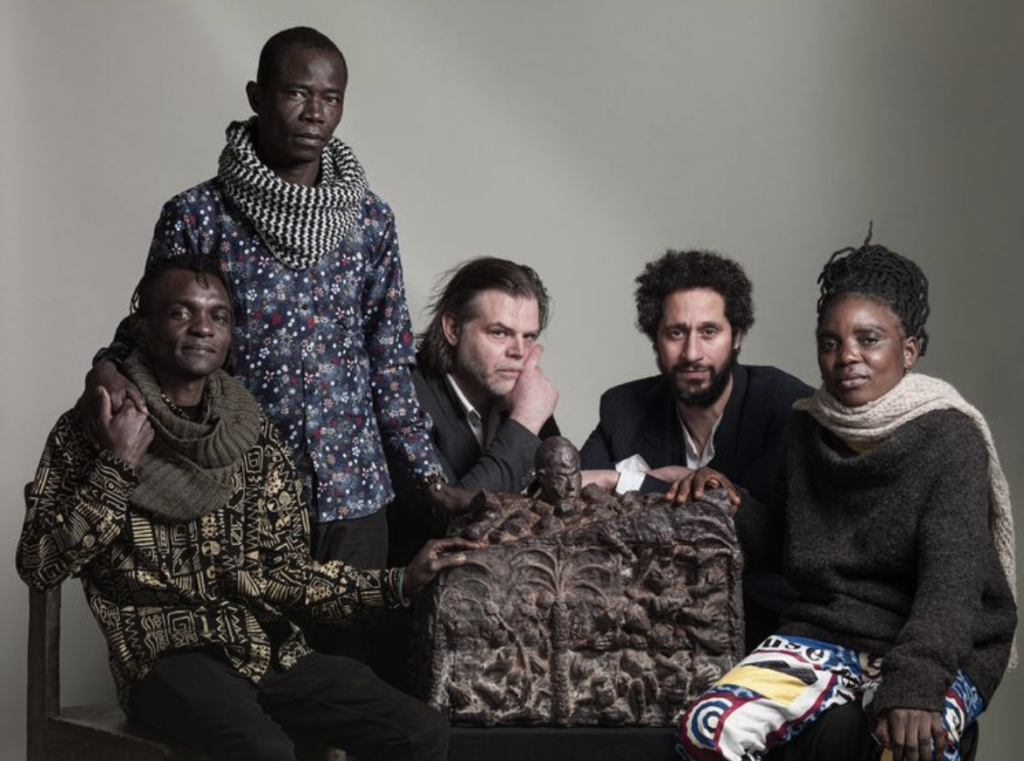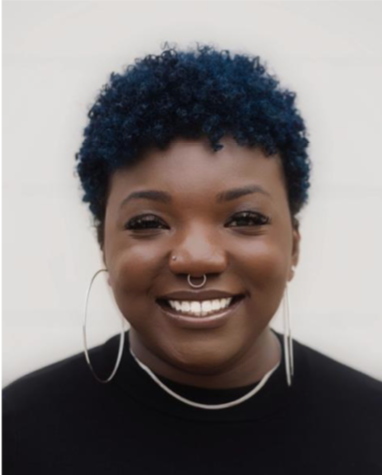Above: Senzeni Mthwakazi Marasela and the red dress from her project, Waiting for Gebane
This Week in African Art and Culture features exciting news of wins in different forms. For a South African artist, this news takes on a literal meaning as she wins the first edition of an award recognizing artists for vision and courage expressed through their works. For another artist from Nigeria, winning is gaining the ability to collaborate with one of the world’s most renowned fashion brands. For an art collective from the Republic of Congo, winning means representing a country at the world’s biggest biennale …
South African Artist Senzeni Marasela Wins Inaugural K21 Global Art Award
South African interdisciplinary artist Senzeni Mthwakazi Marasela has won the first K21 Global Art Award. The award recognizes the vision and courage of emerging or mid-career artists and will, in the future, be awarded annually to internationally recognized artists under the age of 45.
The prize is awarded by the Friends of the Kunstsammlung Nordrhein-Westfalen in Düsseldorf, Germany and is endowed with 70,000 euros (U.S. $77,675). The K21 Global Art Award nomination jury comprised five renowned international curators: Doryun Chong (M+, Hong Kong), Koyo Kouoh (Zeitz Museum of Contemporary Art Cape Town, South Africa), Omar Kholeif (Sharjah Art Foundation, United Arab Emirates), Oluremi C. Onabanjo (Museum of Modern Art, New York) and Jochen Volz (Pinacoteca do Estado de São Paulo, Brazil).
Marasela commented on her win, saying, “I am delighted that my work is having an impact here in Düsseldorf—and hopefully soon beyond the city limits. All my adult life, I have worked with dedication as an artist, and I see this award as an incentive to work with even more conviction and determination. I am grateful to the jury of the K21 Global Art Award and the Friends of the Kunstsammlung Nordrhein-Westfalen for believing in my artistic practice. I hope that this is the beginning of great discussions and cooperations. I also hope that this is a journey that will inspire young artists around the world, especially in Africa.”
Senzeni Mthwakazi Marasela (born 1977 in Thokoza, South Africa) is an interdisciplinary artist whose œuvre combines performance, photography, video, embroidered textiles, printmaking and installations. In 1998, she completed her art studies at the University of Witwatersrand, Johannesburg. Her work has been exhibited widely in South Africa, Europe and the United States and appears in important international collections. In 2015, Marasela was represented at the 56th Venice Biennale. She lives and works in Soweto, South Africa.
A red dress is at the center of the selection of works acquired for the Kunstsammlung Nordrhein-Westfalen. Theodora Mthetyane, the fictional alter ego of Marasela, received it as a gift from her husband, Gebane, when he left the country for the big city of Johannesburg to find work. The ornamentally printed, iseshweshwe dress is worn by married women in Xhosa culture and is widely worn by the rural population. Theodora also wore it every day while she waited unsuccessfully for years for Gebane to return.
Senzeni Marasela, who uses Theodora to allude to her mother’s story and to the situation of many South African women during the apartheid era, wore the dress herself every day for a long period of six years (2013-2019). With this haunting performance, she embodied Theodora’s story, dedicated to the situation of waiting, loneliness and hope, experiencing different reactions ranging from identification to discrimination. The project, Waiting for Gebane, culminated in a large institutional solo exhibition at Zeitz MOCAA (Museum of Contemporary Art) in 2020, in which the groups of works presented here also were exhibited.
Nigerian Photographer Rachel Seidu Collaborates With Yves Saint Laurent’s Rive Droit

Photographer Rachel Seidu has collaborated with Yves Saint Laurent and its Rive Droite stores in Paris and Los Angeles, a curated and creative retail and cultural destination, to showcase her stunning photographs in their retail spaces. This has allowed the Nigerian-born artist to exhibit her work and bring her vision to a wider audience. The exhibition features seven of Seidu’s photographs, each one telling a different story about her environment, her country and her people.
Seidu uses photography to capture moments of vulnerability and tenderness, challenging society’s rigid and oppressive norms. Her images celebrate the real and hidden side of people and create personal and hyper-realistic narratives that are open to exploration.
The artist’s collaboration with Saint Laurent Rive Droite is a notable achievement for the Nigerian-born artist. Her stunning photographs are a demonstration of her talent as a visual storyteller, a testament to the power of art and the importance of collaboration in promoting new voices and perspectives to the forefront as she has gradually taken up space by carving a niche for herself in the past three years across varying platforms.
Rachel Seidu (born 1997) is a visual artist working across photography and film, creating intimate, emotive portraits reflecting diverse stories and realities. Her practice involves a technical exploration of and experimentation with shadows, contrast and natural lighting. She tells stories through her portraits and documentary shots that capture the essence of her subjects and their surroundings. Her images are reminiscent of works by Andrew Dosunmu, an older Nigerian photographer and filmmaker, which, in a similar fashion, dare to challenge stereotypes associated with African culture, gender and identity.
In 2022, Seidu photographed the cover of the 2022 edition of We Need New Names, the Booker-shortlisted novel by Zimbabwean author NoViolet Bulawayo. She also was shortlisted for the James Barnor and Yaa Asantewaa Prize in 2022. Selected group exhibitions she has participated in include Let’s take a moment (2022), Sòrò Sókè (2022), Young Contemporaries Exhibition (2020), and Boundaries of Reason(2021), Abuja Photo Festival, Abuja, Nigeria. Seidu is a member of Black Women Photographers and the African Photojournalism Database. She lives and works in Lagos, Nigeria.
Congolese Plantation Workers’ Art Collective (CATPC) To Represent The Netherlands at 2024 Venice Biennale

A renowned group of plantation workers from the Democratic Republic of the Congo (DRC), the Cercle d’Art des Travailleurs de Plantation Congolaise (CATPC), will represent the Netherlands at the 2024 Venice Biennale. The 60th International Art Exhibition, La Biennale di Venezia, will take place from April 20-Nov. 24, 2024.
The CATPC is an artist collective from Lusanga, DRC. It was founded in 2014 in Lusanga. The CATPC, also known as the collective, consists of 20 members. It is famous for creating sculptures made from cacao sourced from different plantations throughout the world.
According to the CATPC, creating art is a sacred activity, and art is a living force born of a sacred Earth. The artworks of the CATPC have been said to be cathartic containers that both absorb the suffering and evil of colonialism’s ongoing catastrophe while acting as symbols of hope and restoration. The proceeds from the sales of these works have been used to support Congo, with the funds going into reclaiming and transforming former plantations into biodiverse nature and other ventures.
There will be two CATPC presentations. One will open at the Rietveld Pavilion in Venice, and the other will open simultaneously at the White Cube, the Lusanga art space that artist Renzo Martens, who is the CATPC’s collaborator, and the CATPC operate in Lusanga, DRC. The two presentations will be directly mirrored and connected.
One of the major themes of the presentation is restitution. In an effort to contribute to the conversation on colonialism in the (international) art community, restitution will be emphasized in a variety of ways.
On the presentation at the 2024 Venice Biennale, Ced’art Tamasala, a member of the CATPC said, “The opportunity to now pair a white cube on a plantation with one at the summit of the art world allows for a direct look into these two worlds and into the inequalities between them. Meaningful and sincere reflections will be produced from these different, but related, realities coming together. Through this presentation, we will come to the final stage of our collective journey into truths that deserve to be shared.”
This will mark the Netherlands’ comeback to the Giardini, the space where many of the busiest national presentations have been hosted. Last year, the Netherlands turned over its pavilion to Estonia and instead staged its presentation, by the artist Melanie Bonajo, in a deconsecrated 13th-century church far away from the Biennial’s main festivities.
Not All Realisms (Photography, Africa and the Long 1960s) at Smart Museum of Art, Chicago

Currently on view at the Smart Museum of Art at the University of Chicago is a photography exhibition titled Not All Realisms (Photography, Africa and the Long 1960s). For many parts of Africa, to refer to the 1960s is to gesture broadly toward a time of great transformation: the postcolonial turn. That decade’s beginning marks a wave of national independence movements coming to fruition in all parts of the continent with far-reaching consequences around the globe.
However, that era of sweeping change is bound up in a chain of events long preceding that watershed decade, with ramifications that reach potently into our present. And any discussions that merely offer a colonial/postcolonial dichotomy or that are framed exclusively through the nation-state betray the far more complex collective and individual experiences of that time and the visual representations taking place within it.
This exhibition addresses photography in the context of Africa’s historical 1960s—amid resistance, revolution, new nationalist and transnational movements, and the stuff of daily life therein. Focusing on Ghana, Mali and South Africa, the exhibition features photographic prints, reprints, books, magazines, posters and other materials through which photography’s relationships to real people and events were articulated, produced and circulated. And it looks to contemporary works that engage and reflect on those material histories and might prompt us to ask, did the ‘60s ever end?
Bridging the division often made between studio photography and reportage—even as many photographers worked across such categories in their practices—not all realisms brings studio and street together. This project explores documentary visions cultivated through the international circulation of print media and transnational dialogues and examines the multiple lives of single images made by photographers including Ernest Cole, Malick Sidibé, James Barnor, Peter Magubane, Paul Strand, Henri Cartier-Bresson, and more.
The exhibition is on view until June 4, 2023.











